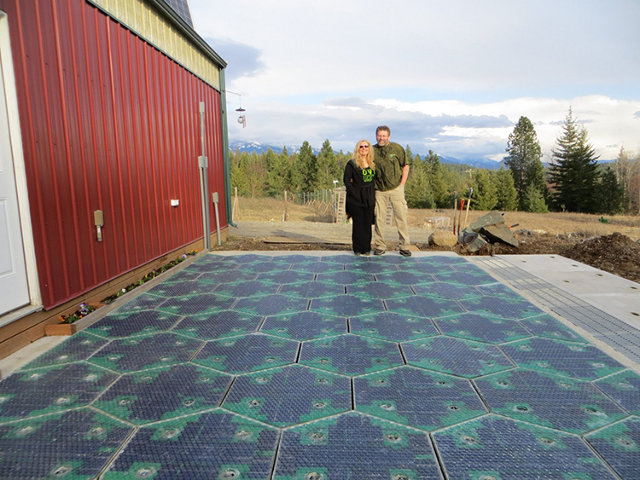The founders of the Solar Roadways project want to cover highways in thick, LED-lit glass.
There are nearly 18,000 square miles of roads in the U.S., an area that’s bigger than the entire states of New Hampshire and Massachusetts combined. By some estimates, there are also as many as 2 billion parking spaces. Since most of that pavement is soaking up sun all day long, a couple of entrepreneurs had an idea: Why not put it to use generating solar power?
The Solar Roadways project, now crowdfunding on Indiegogo, hopes to re-pave the country in custom, glass-covered solar panels that are strong enough to drive on while generating enough power to light the road, melt ice and snow, and send extra energy to cities. Eventually, if every paved surface was covered in the product, the panels would produce more power than the nation uses.

The project began eight years ago, when founders Scott and Julie Brusaw decided to take a chance on developing an idea that no one thought would work. “Driving on glass had never been done,” says Scott Brusaw. “We had a few big hurdles in the beginning. How do you put a traction surface on glass so the first time it rains everybody doesn’t slide off the road? How do you make glass tough enough to withstand the weight of 18-wheelers? What happens if someone’s walking out of Home Depot and drops an eight-pound sledgehammer?”
Glass, it turns out, is stronger than you might think. “You first mention glass, people think of your kitchen window,” Brusaw says. “But think of bulletproof glass or bomb resistant glass. You can make it any way you want. Basically bulletproof glass is several sheets of tempered glass laminated together. That’s what we have, only our glass is a half inch thick, and tempered, and laminated.”
It’s strong enough to easily withstand cars, fully loaded trucks, and even 250,000-pound oil drilling equipment. The textured surface means it isn’t slippery, and since it can self-power small heaters inside to melt ice in winter, it’s supposedly safer than an ordinary road. It also powers small LED lights inside that can light up dividing lines and spell out warning messages–if motion sensors detect a deer crossing the road, the lights can automatically tell drivers to slow down.
At parking lots or rest stops along highways, the panels could power a continuous network of charging stations for electric cars. Eventually, the designers believe it may be possible to charge the cars directly through the road as they drive. In the future, driverless cars could also use the panels to continuously report their location.
Since the whole road is wired, it’s also easy to maintain: If one panel stops working, all of the other panels around it call a local repair shop with the exact location. “A guy can come out and repair it in five minutes,” Brusaw says. “Compare that to pothole repair.”
Using the $1 million they hope to raise on Indiegogo, the company plans to hire more engineers and continue refining the current product, testing it first on parking lots and smaller roads before moving on to highways across the entire country. Hunting down the funding to cover the U.S. (or even a significant portion) in solar roadways, however, will be an insanely big challenge.